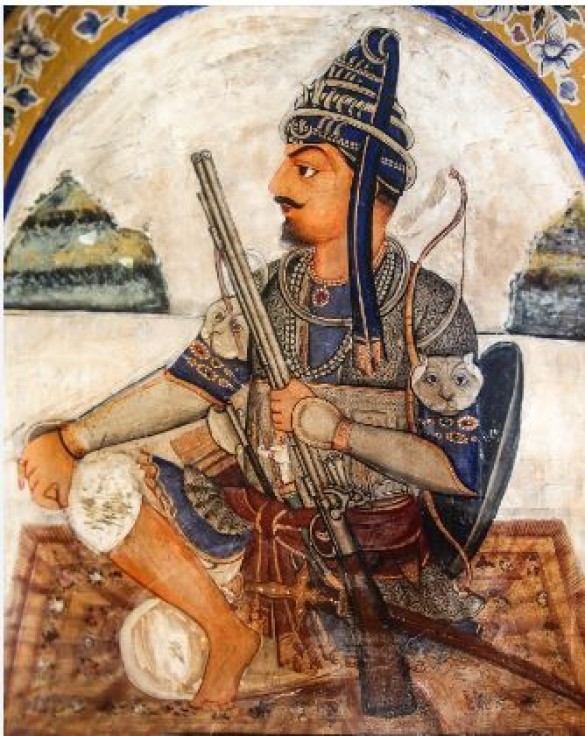
The seventh head of the Budha Dal, Akali Baba Hanuman Singh Ji (1755–1845), was born to Baba Garja Singh Ji and Mata Harnam Kaur Ji in the Punjabi village of Naurang Singh Wala, close to Zira, in the Firozpur region. Under the direction of the fifth and sixth Jathedars of the Budha Dal, Akaali Baba Naina Singh Ji and Akaali Baba Phula Singh Ji, respectively, Baba Ji participated in a number of important engagements.
After the Shaheedi of Akaali Phula Singh Ji at Naushera in 1823, Baba Hanuman Singh Ji became the leader of the Akaali Nihangs, as well as the Jathedar of Akaal Takht Sahib at the age of 68 years old.
Also Read: Jassa Singh Ahluwalia: Spiritual Leader
When Akaali Baba Hanuman Singh Ji assumed the position of Jathedar of the Sikh nation, the Panth was going through a very trying time. In 1839, the treacherous Dogra family sold off the Lahore Darbar to the British, the death of Ranjit Singh, the Maharaja of Punjab, and British plans to annex Punjab were all taking place.
The most dependable Sikh general at the time, Maharani Jind Kaur, the Empress of the Sikh kingdom of Punjab, visited the holy city of Amritsar and asked Jathedar Hanuman Singh for support in fighting the British.
Sham Singh approached Baba Hanuman Singh at the Akal Takht and said, "Baba Ji, I want to fight against the British, but I have no army. I only have my two sons and myself.
"Oh Singh Ji, who does this Akaali fauj belong to, if not to the Sikh nation," Baba Ji retorted.
Sardar Sham Singh Ji, Attarivala, and many other Sikh warriors died in battle against the British army during the Battle of Sabraon in 1846, causing terrible losses to the invaders.
Also Read: Chardi Kala: An Ascending Energy
The surviving Singhs moved to Patiala, the Sikh Princely realm, to set up camp with Baba Hanuman Singh Ji. Due to his fear of retaliation for his backing of the British, Maharaja Karam Singh (1798–1845), the King of Patiala, informed the British about the location of the Jathedar and Sikh army when he learned that the knights of the Tenth Sikh Guru were camped out in his territory.
The Sikh Maharajahs of Patiala, Jind, and Faridkot, as well as other traitors, surrounded Baba Ji and the Sikh warriors, and the British army and their Patiala, Jind, and Faridkot Sikh stooges commenced cannon fire on the Sikhs. At the location where the ninth Sikh Guru's iconic Gurdwara Dukh Niwaran currently stands in the city of Patiala, 15,000 Sikhs were martyred. According to oral tradition from the Budha Dal, 32,000 Singhs were killed in this conflict.
Jathedar Baba Hanuman Singh Ji, the Sikh army's commander, and about 500 Nihang warriors managed to survive this attack and continued to engage the British army's heavy cannon fire with swords, bows and arrows, axes, and matchlock fire.
Also Read: Bibi Deep Kaur Ji: Fearless Fighter
Finally, in 1845, at the age of 90, the valiant Jathedar of the Guru's beloved Khalsa, Akali Baba Hanuman Singh Ji, lost his battle for the liberation of the people of Punjab after running out of gunpowder and witnessing thousands of Sikh soldiers attain shaheed.
Akali Baba Prehlada Singh Ji became the eighth leader of the Akali Nihang Singh Khalsa following the martyrdom of Baba Hanuman Singh. The British gave the Nihang Singhs a shoot-to-kill order, and Baba Prehlada Singh proceeded toward the revered Takht Sahib in Nander to gather the Akali army. To preserve the legacy of the Guru's army, the few remaining Nihang Singhs either relocated camp to the woods of Punjab and Rajputana or went with Baba Ji in the direction of Hazoor Sahib.
Also Read: Rani Sada Kaur: A Sikh Leader
Gurudwara Manikaran sahib: Significance Of Hot Spring
Turban: Mark Of Sovereignty And A Crown